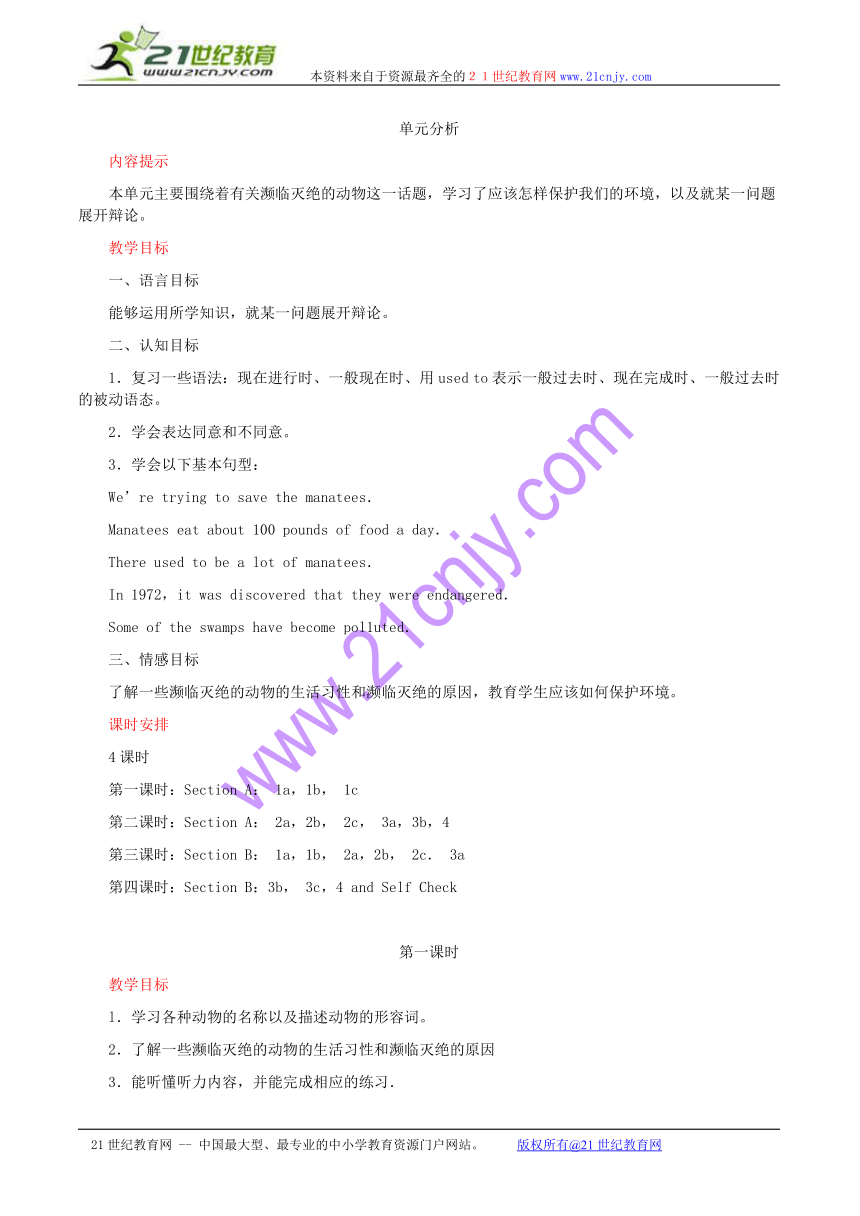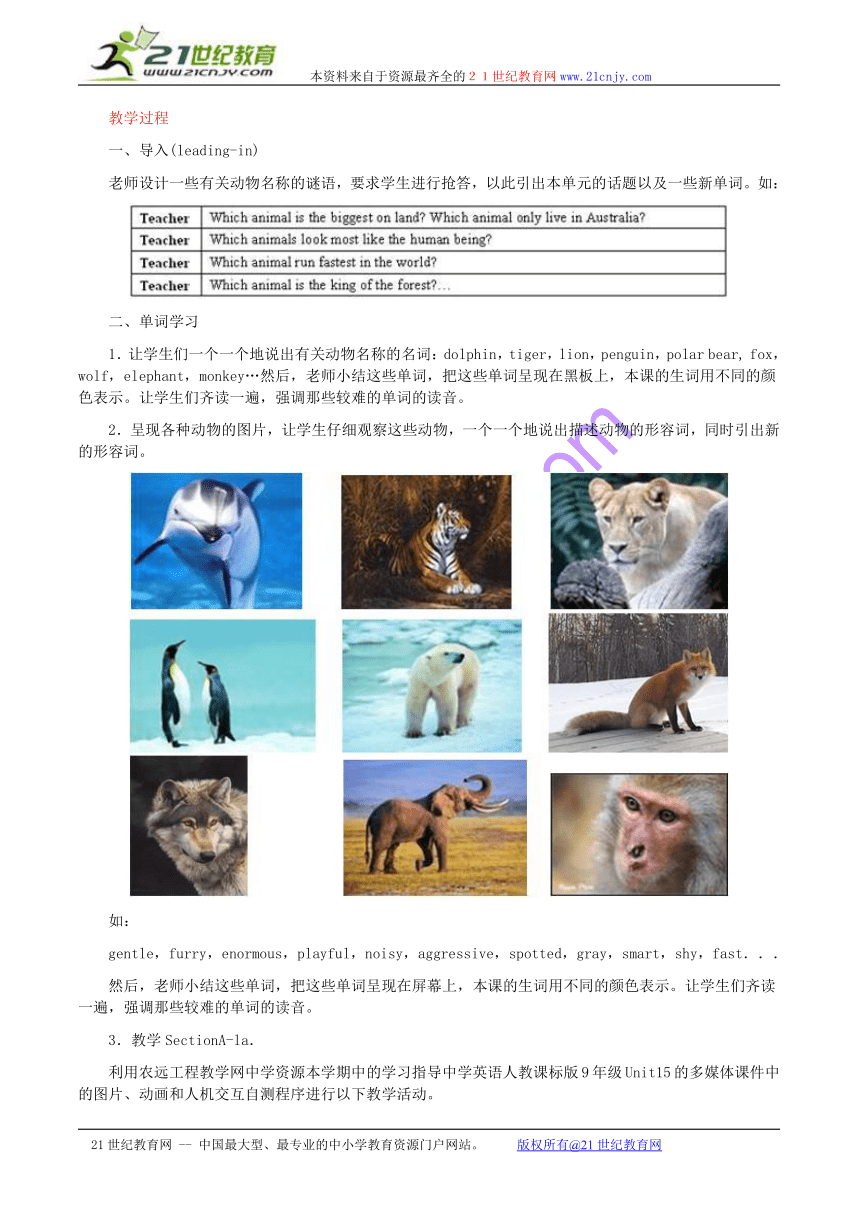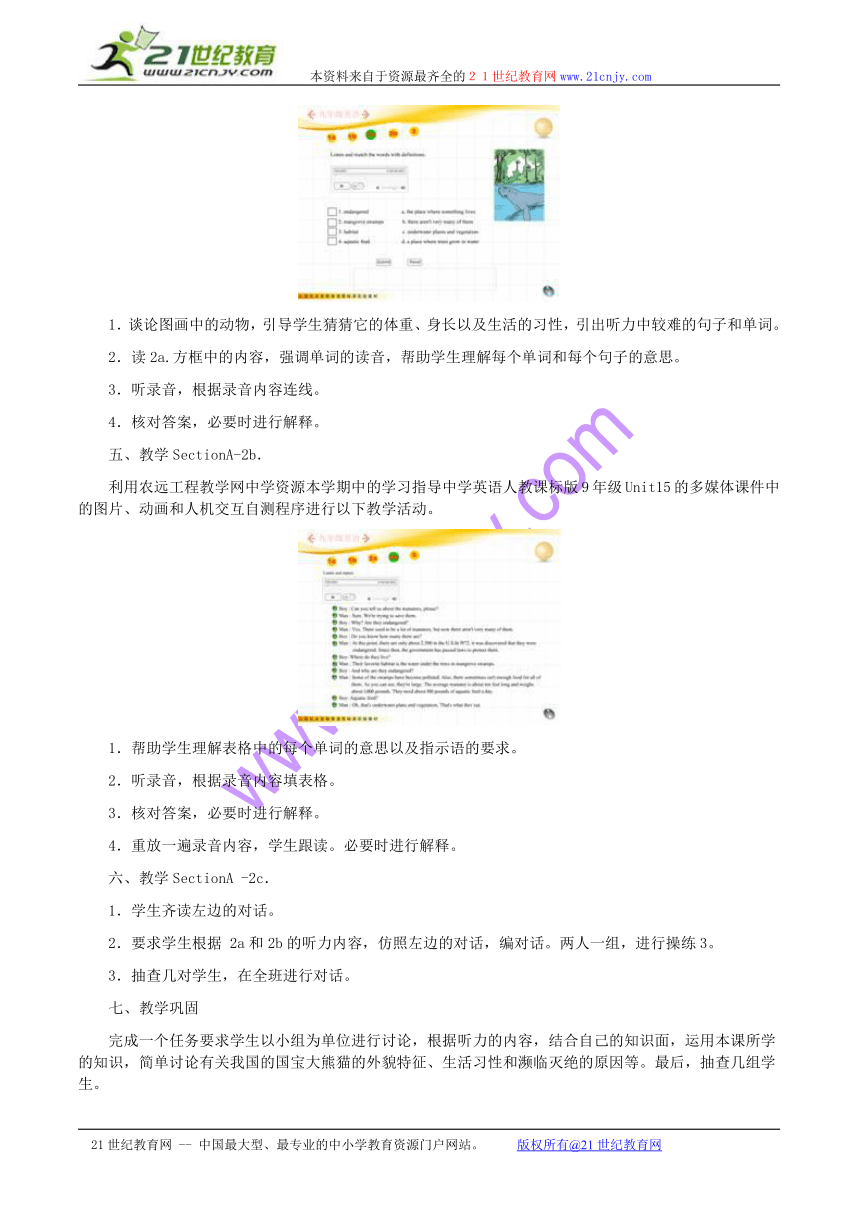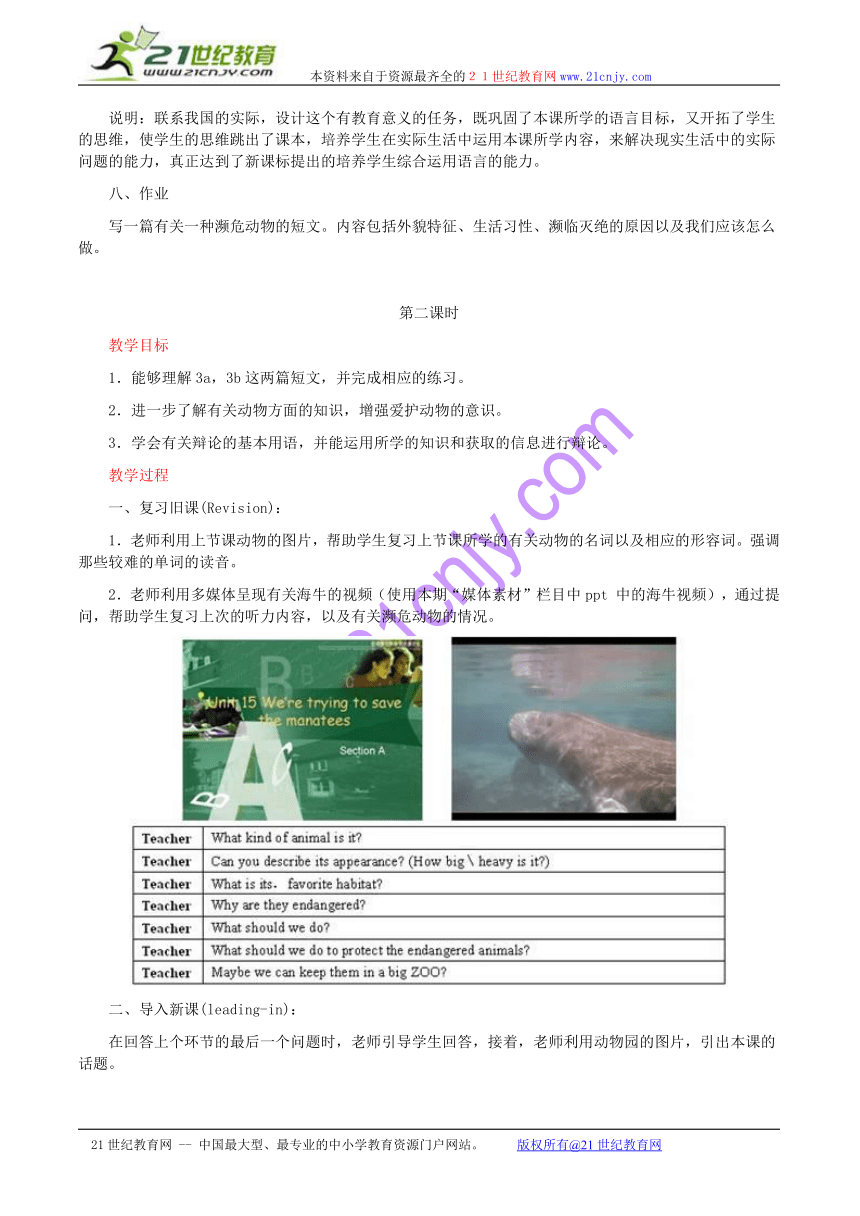Unit 15 We’re trying to save the manatees!(含习题及答案)
文档属性
| 名称 | Unit 15 We’re trying to save the manatees!(含习题及答案) |  | |
| 格式 | rar | ||
| 文件大小 | 294.7KB | ||
| 资源类型 | 教案 | ||
| 版本资源 | 人教新目标(Go for it)版 | ||
| 科目 | 英语 | ||
| 更新时间 | 2010-04-07 13:10:00 | ||
图片预览





文档简介
本资料来自于资源最齐全的21世纪教育网www.21cnjy.com
单元分析
内容提示
本单元主要围绕着有关濒临灭绝的动物这一话题,学习了应该怎样保护我们的环境,以及就某一问题展开辩论。
教学目标
一、语言目标
能够运用所学知识,就某一问题展开辩论。
二、认知目标
1.复习一些语法:现在进行时、一般现在时、用used to表示一般过去时、现在完成时、一般过去时的被动语态。
2.学会表达同意和不同意。
3.学会以下基本句型:
We’re trying to save the manatees.
Manatees eat about 100 pounds of food a day.
There used to be a lot of manatees.
In 1972,it was discovered that they were endangered.
Some of the swamps have become pol1uted.
三、情感目标
了解一些濒临灭绝的动物的生活习性和濒临灭绝的原因,教育学生应该如何保护环境。
课时安排
4课时
第一课时:Section A: 1a,1b, 1c
第二课时:Section A: 2a,2b, 2c, 3a,3b,4
第三课时:Section B: 1a,1b, 2a,2b, 2c. 3a
第四课时:Section B:3b, 3c,4 and Self Check
第一课时
教学目标
l.学习各种动物的名称以及描述动物的形容词。
2.了解一些濒临灭绝的动物的生活习性和濒临灭绝的原因
3.能听懂听力内容,并能完成相应的练习.
教学过程
一、导入(leading-in)
老师设计一些有关动物名称的谜语,要求学生进行抢答,以此引出本单元的话题以及一些新单词。如:
二、单词学习
1.让学生们一个一个地说出有关动物名称的名词:dolphin,tiger,lion,penguin,polar bear, fox,wolf,elephant,monkey…然后,老师小结这些单词,把这些单词呈现在黑板上,本课的生词用不同的颜色表示。让学生们齐读一遍,强调那些较难的单词的读音。
2.呈现各种动物的图片,让学生仔细观察这些动物,一个一个地说出描述动物的形容词,同时引出新的形容词。
如:
gentle,furry,enormous,playful,noisy,aggressive,spotted,gray,smart,shy,fast...
然后,老师小结这些单词,把这些单词呈现在屏幕上,本课的生词用不同的颜色表示。让学生们齐读一遍,强调那些较难的单词的读音。
3.教学SectionA-la.
利用农远工程教学网中学资源本学期中的学习指导中学英语人教课标版9年级Unit15的多媒体课件中的图片、动画和人机交互自测程序进行以下教学活动。
(1).学生观看la中的图画,读出图画中有关动物的单词。强调那些较难的单词的读音。
(2).学生读图画上方的形容词,确保学生明白每个单词的意思。强调那些较难的单词的读音。
(3).引导学生读懂la的指示语,学生根据指示语的要求,把形容词填在相应的位置上,并增加另外一些形容词。
(4).核对答案。要求不同的学生给出不同的答案,简要评出最贴切的答案,仅供参考。
4、教学SectionA-1b.
利用农远工程教学网中学资源本学期中的学习指导中学英语人教课标版9年级Unit15的多媒体课件中的图片、动画和人机交互自测程序进行以下教学活动。
首先,帮助学生明确本题的要求。接着,听力练习,学生根据录音内容,在单词表中圈出所听到的形容词。然后,核对答案。最后,重放一遍录音内容,学生跟读。必要时进行解释。
三、教学SectionA -1c.
1.帮助学生明确本题的要求。接着,要求学生读左边的对话,确保学生明白其中的含义。
2.要求学生在两三分钟内,写下几句描述和自己在某方面相似的动物的句子。
3.要求几位学生读出自己的句子,其他同学进行抢答,猜出他所描述的动物。
四、教学SectionA -2a.
利用农远工程教学网中学资源本学期中的学习指导中学英语人教课标版9年级Unit15的多媒体课件中的图片、动画和人机交互自测程序进行以下教学活动。
1.谈论图画中的动物,引导学生猜猜它的体重、身长以及生活的习性,引出听力中较难的句子和单词。
2.读2a.方框中的内容,强调单词的读音,帮助学生理解每个单词和每个句子的意思。
3.听录音,根据录音内容连线。
4.核对答案,必要时进行解释。
五、教学SectionA-2b.
利用农远工程教学网中学资源本学期中的学习指导中学英语人教课标版9年级Unit15的多媒体课件中的图片、动画和人机交互自测程序进行以下教学活动。
1.帮助学生理解表格中的每个单词的意思以及指示语的要求。
2.听录音,根据录音内容填表格。
3.核对答案,必要时进行解释。
4.重放一遍录音内容,学生跟读。必要时进行解释。
六、教学SectionA -2c.
1.学生齐读左边的对话。
2.要求学生根据 2a和2b的听力内容,仿照左边的对话,编对话。两人一组,进行操练3。
3.抽查几对学生,在全班进行对话。
七、教学巩固
完成一个任务要求学生以小组为单位进行讨论,根据听力的内容,结合自己的知识面,运用本课所学的知识,简单讨论有关我国的国宝大熊猫的外貌特征、生活习性和濒临灭绝的原因等。最后,抽查几组学生。
说明:联系我国的实际,设计这个有教育意义的任务,既巩固了本课所学的语言目标,又开拓了学生的思维,使学生的思维跳出了课本,培养学生在实际生活中运用本课所学内容,来解决现实生活中的实际问题的能力,真正达到了新课标提出的培养学生综合运用语言的能力。
八、作业
写一篇有关一种濒危动物的短文。内容包括外貌特征、生活习性、濒临灭绝的原因以及我们应该怎么做。
第二课时
教学目标
1.能够理解3a,3b这两篇短文,并完成相应的练习。
2.进一步了解有关动物方面的知识,增强爱护动物的意识。
3.学会有关辩论的基本用语,并能运用所学的知识和获取的信息进行辩论。
教学过程
一、复习旧课(Revision):
1.老师利用上节课动物的图片,帮助学生复习上节课所学的有关动物的名词以及相应的形容词。强调那些较难的单词的读音。
2.老师利用多媒体呈现有关海牛的视频(使用本期“媒体素材”栏目中ppt 中的海牛视频),通过提问,帮助学生复习上次的听力内容,以及有关濒危动物的情况。
二、导入新课(leading-in):
在回答上个环节的最后一个问题时,老师引导学生回答,接着,老师利用动物园的图片,引出本课的话题。
板书:Are ZOOS good or bad for animals
三、阅读SectionA-3a.
1.引入:老师介绍中西方有关动物的文化差异。
利用农远工程教学网中学资源本学期中的学习指导中学英语人教课标版9年级Unit15的多媒体课件中的图片、动画和人机交互自测程序进行以下教学活动。
2.学生阅读3a.中的信件, 按照指示语的要求,划出不支持动物园的理由。
3.老师通读课文,划出重要词组,讲解文中较难的句子。
4.学生齐读课文,进一步理解文中的意思。
四、运用同样的方法和过程,来学习SectionA-3b.
五、教学巩固
Debate.针对“动物园是否对动物有利”展开辩论。
1. 帮助学生理解指示语的意思。
2.学生阅读方框里的句型,确信学生明白他们的意思,为辩论做好准备。
3.老师做一个示范。
4.把整个班分成正方和反方两个部分。要求学生以组为单位进行讨论,并写下有利于
自己辩论的关键的单词或句子。同时,老师巡视课室,检查学生的进展,必要时提供帮助。
5.两组学生在课堂上展开辩论。老师旁听,必要时给予帮助。
六、作业
1.完成workbook中的部分练习。
2.以“Zoos are good\bad for animals.”为题,写一篇短文。
第三课时
教学目标
1.能进一步地扩展所学的内容,能用目标语言谈论如何保护环境,从而拯救地球。
2.能听懂2a和2b的听力内容,并完成相应的练习。
3.能理解3a的内容,并完成相应的练习。
教学过程
一、复习旧课(Revision):
老师呈现一张海牛的图片。通过对学生提出一些相关的问题,帮助学生复习前两节课所学的内容。(包括有关海牛的描述,如何保护濒危动物,以及动物园是否有利于动物的健康等。) 问题如下:
二、引出新课(Presentation):
1.老师接着上一个环节的话题。
2.老师呈现一些有关环境污染的画面:有交通拥挤,有浪费水电的画面,有白色污染的画面等等。老师引导学生谈论画面中的污染现象。
3. 引出SectionB-1a中的句子,并把他们呈现在屏幕上。然后,要求学生朗读这几句话,并按照指示语的要求,把他们按难易程度排序。最后,仿照SectionB-1b,两人一组,进行讨论。
三、教学SectionB-2a.
利用农远工程教学网中学资源本学期中的学习指导中学英语人教课标版9年级Unit15的多媒体课件中的图片、动画和人机交互自测程序进行以下教学活动。
1. 老师引出听力的主要内容。
2. 讲解表格内容,要求学生读表格中的句子,确保学生理解每个句子的意思。
3. 放录音,要求学生根据录音内容勾出Things Julia and Jack talk about。
4. 核对答案。必要时进行解释。
四、教学SectionB-2b.
利用农远工程教学网中学资源本学期中的学习指导中学英语人教课标版9年级Unit15的多媒体课件中的图片、动画和人机交互自测程序进行以下教学活动。
1. 老师读并讲解指示语,确信学生明白它的意思。
2. 重放录音,要求学生根据录音内容,分别勾出Julia正在做,将要做以及将永远不会做的事情。
3. 核对答案。必要时进行解释。
4. 要求学生跟着录音,重复录音内容,明白每句话的意思。必要时进行解释。
五、教学巩固SectionB-2c.
围绕着怎样保护环境,要求学生根据2a中提供的词组,联系自己的实际情况,模仿右边的对话,两人一组进行操练。在学生进行操练的同时,老师巡视课室,检查学生的进展,必要时提供帮助。最后,抽查几组学生的对话,必要时及时给予适当的鼓励。
六、教学SectionB -3a.(阅读训练)
利用农远工程教学网中学资源本学期中的学习指导中学英语人教课标版9年级Unit15的多媒体课件中的图片、动画和人机交互自测程序进行以下教学活动。
1.引入:谈论课文右上方的图画。T:Is this house special Why
2.快速阅读课文,找出一个问题的答案。Why is the house special
3.老师讲解课文中的难点,并划出文中的重要词组和句子。
4.再次精读课文,按照指示语的要求,写出五个你想问的问题。两人一组,交换自己的问题,并讨论问这些问题的原因。
5.核对答案。引出学生们各种不同的问题,并要求简要说出问这些问题的原因。
Answer-s will vary but might include…
Who taught her how to make her house
What isn’t made out of trash in her house
When did she start making her trash,house
Where is the house
Why did she use trash to build a house
How long did it take to build her house?
6.全班齐读课文。
七、作业
1.完成练习册中的相应练习。
2.熟读课文。
3.以How to save our environment为题,写一篇短文。要求运用本课所学的知识,联系自己的实际,从我做起,从小事做起。
第四课时
教学目标
1.能运用目标语言,来描述并写出有关环保的情况。
2.复习整个单元的主要内容,并做一些相应的练习进行检测。
教学过程
一、复习旧课(Revision):
1.老师呈现本单元课文中的几幅主要的图画P118,P121,P122等。针对本单元课文里的内容,老师提出一些相应的问题,来帮助学生复习本单元的内容和语法点。
如:
针对P118的图画,老师可以提这样的问题:
2.老师指着图中的海牛提问:
3.老师接着上面的话题继续说,同时呈现有关的图片。帮助并引导学生回答Section B la中的几个句子。
二、引入新课(Presentation):
1.利用农远工程教学网中学资源本学期中的学习指导中学英语人教课标版9年级Unit15的多媒体课件,通过提出一些相关的问题,帮助学生回忆昨天所学的文章的内容。
2.引出本课写作时将要用到的重要的词组。Be made from,used to be.并把这两个重要的词组写到黑板上。
三、写作SectionB-3b.(writing):
1.学生读懂本部分的指示语。
2.谈论这两幅图画的区别。首先问学生们在第一幅图里能看到什么东西。(a trash can,a pair of pants,a napkin)然后,再谈论第二幅图画,Ask students to find things made from recycled materials from the first picture.(the backpack,the hat,the scarf)
3.要求一个成绩较好的学生运用“made from”和“used to be”造一个例句。如:His backpack used to be a pair of pants.His backpack is made from a pair of pants.
4.学生按照要求,完成3b部分的写作。在学生进行写作的同时,老师在教室内四处走动,随时关注学生们的写作情况,并对那些需要帮助的学生及时给予相应的有针对性的指导。
5.在大部分学生完成后,老师将抽出几篇作文,借助多媒体投影,在全班同学面前,当场进行展示和点评。让学生们一起来学习作文中好的方面,同时,一起来改正作文中所出现的一些错误。最后,老师进行小结,明确地指出这篇作文应该怎么写,从哪几个方面写,在写作过程中应该注意哪几点(时态,人称,重要句型以及重要的词组等)。
说明:当场展示和点评学生的作文,不仅可以让学生们对作文中的优点及作文中所犯的错误留下深刻的印象,同时也能够增强学生们的自信心和学习兴趣。必须强调的是老师在点评作文时,一定要以鼓励为主。
参考范文:
His hat used to be(is made from)a trash can cover.His backpack used to be (is made from) a pair of pants.His scarf used to be (is made from) a napkin.
四、教学巩固
Survey
1.要求学生读懂指示语。要求学生说出一些可以循环再利用的物品。如:(paper,glass,aluminum cans,plastic,cardboard…)
2.讲解右边的调查表,确保每个学生明白如何进行调查。
3.帮助学生增加一些调查的内容。如:recycle glass,turn off water while washing hair...
4.让一位成绩较好的学生做一个示范。
5.要求学生离开自己的座位,分别调查四位同学是否循环再利用过废品,并把调查的结果填在表格中。
6.抽查几位学生,在全班展示他们的调查结果。
五、巩固练习(Self Check):
Exl:
(1)学生读被选的单词和词组,确保学生明白每个单词和词组的意思。
(2)让学生按要求填写单词和词组。强调注意词型的变化。
(3)核对答案。老师利用多媒体投影,让全班同学一起来修改某一个学生的答案,同时给出正确答案。
(4)让学生根据要求,用所选的单词和词组造句。强调应注意人称、时态、词型的变化以及句子的意思。
(5)用同样的方法来核对答案。
Ex2:
(1)读懂指示语。
(2)要求一位成绩较好的学生做一个示范。注意纠正他的语法和语音错误。
(3)要求学生两人一组,谈论完成以下的对话。
(4)抽查几对学生,在全班展示他们的对话。
六、作业
1.完成练习中的练习。
2.请以“Recycle Materials”为题写一篇短文。主要内容:请你利用Recycle Materials设计一套服装或一套房子等,运用本单元所学的内容,写成一篇短文,并充分利用自己的想象,画一幅图画。
习题精选
一、用所给词的适当形式填空。
1.Kangaroos are ______ (play) and chimpanzees are _____ (noise).
2. I was ____ (surprise) to find hardly anyone in the zoo.
3. Visiting zoos are like ____ (live) textbooks for young people.
4. He ____ (use) to be ____ (call) “Little Tiger”.
5.Liu Xiang’s success is an ____(inspire)to us all
二、选择正确答案。
( )1.My jacket has ____ color ____ yours, but mine is bigger than yours.
A. the same, as B. same , as C. different, from D. the same, to
( )2. Wang Mei ____ her mother because she is beautiful and intelligent.
A. look B. liked C. is like D. look like
( )3. The teacher _____ to Li Lei,“You ____ very good English.”
A. say, speak B. talk, say C. speak, talk D. said, speak
( )4. President Bush ____ a visit ____ China last month.
A. pay, in B. paid, to C. gave, in D. paid, for
( )5.There will not be enough space to _____ the earth in the future.
A. live on B. live in C. live on in D. live in on
( )6.At last, Lucy make the baby ____ and the baby began to laugh.
A. stop crying B. to stop crying C. stop to say D. to stop to cry
( )7. Do you ____ a cat ____ a pet at home
A. have , as B. keep, for C. keep, as D. Both A and C
( )8. The president _____ all people _____ our environment.
A. urge, protect B. urged, to protect C. urges, protect D. urged, protect
( )9. I feel that the zoo ____ a clean and safe place ____ animals .
A. provide, for B. gives, for C. provides, for D. provides, to
( )10.I think the environment is really important. ____, I like ____ my bike.
A. Beside, riding B. Besides, riding C. Except, to ride D. Except, riding
三、根据汉语提示,完成下列句子。(横线处不限词数)
1.这个教室有 10米长, 6米宽。
The classroom is ______________________________________.
2.她很有耐性,非常适合教学生。
She is very patient and she is _______________________________.
3.这条河不像过去那样干净了。
The river ____________________ it ________________________.
4.妈妈在上班的路上看到了我的英语老师。
My mother saw my English teacher __________________________.
5.他的腿坏了,几乎不能移动。
His leg is broken and he can ________________________________.
6.你同意我说的话吗?
Do you ___________________________________________________
7.我们应该爱护动物,关爱地球。
We should ______________ animals and ____________ the earth.
8.离开房间时不要忘记关灯。
Don’t forget ________________________ when you leave the room.
9.回收书和纸很容易,但对保护环境很重要。
_________________________ is easy. But it is very important for protecting the environment.
10.洗头的时候你最好关掉淋浴器。
You’d better ______________________ when you wash your hair.
四、阅读理解。
A
I will tell you the story of the ant and the grasshopper (蝗虫). It is a cold winter’s day and an ant is bringing out some grains of corn (谷粒). He gathered (收集)them in the summer. He wants to dry them. The grasshopper is hungry. He sees the ant and says, “Give me a few grains corn; I am dying of hunger(饿死). ”
“But, ”says the ant, “what did you do in the summer Didn’t you store up(贮藏)some corn ”
“No, ”says the grasshopper, “I was too busy. ”
“What did you do ”asks the ant.
“I sang all day, ”answers the grasshopper.
“If you sang all summer, ”says the ant, “you can dance all winter. ”
1.The ant dries the grains of corn _______.
A. in the summer B. in the winter
C. on weekdays D. when he is hungry
2.The grasshopper is very hungry because he only ________ in the summer.
A. danced B. dried the grains
C. stored up corn D. sang
3.The ant gave the grasshopper ________.
A. some grains of corn B. something to eat
C. nothing D. some rice
4.The title (题目)of the story may be _______.
A. The Ant and the Grasshopper
B. The Ant Sings and Dances
C. The Busy Ant and the Happy Grasshopper
D. Store up Some Corn and You’ll Be Hungry
5.From the story we can know ________.
A. the ant is our good friend
B. we must think before we do anything
C. people must help others
D. we must work hard for a good life
B
Pollution
Hundreds of years ago, life was much harder than it is today. People didn’t have modern machines. There was no modern medicine, either.
Life today has brought new problems. One of the biggest is pollution (污染). Water pollution has made our rivers and lakes dirty. It kills our fish and polluted our drinking water. Noise pollution makes us talk louder and become angry more easily. Air pollution is the most serious kind of pollution. It’s bad to all living things in the world.
Cars, planes and factories all pollute our air every day. Sometimes the polluted air is so thick that it is like a quilt over a city. This kind of quilt is called smog(烟雾).
Many countries are making rules to fight pollution. Factories must now clean their water before it is thrown away, they mustn’t blow dirty smoke into the air.
We need to do many other things. We can put waste things in the dustbin and not throw it on the ground. We can go to work by bus or with our friends in the same car. If there are fewer people driving, there will be less pollution.
Rules are not enough. Every person must help to fight pollution.
1.Hundreds of years ago, life was much harder than it is today because _______.
A. there were not any modern machines
B. there was no modern medicine
C. both A and B
D. there were not many people
2.What is the biggest problem in today’s life
A. Water pollution B. Air pollution
C. Noise D. Pollution
3.The most serious kind of pollution is ________.
A. noise pollution B. air pollution
C. water pollution D. A, B and C
4.Factories must clean their water ________.
A. before they are thrown away
B. when they are thrown away
C. after it is thrown away
D. before it is thrown away
5.From the passage we know that ________.
A. a few years ago, there was no smog at all
B. today people don’t have to talk to each other in a loud voice
C. we can drink water from the polluted rivers and lakes’
D. people are making rules in order to fight pollution
五、书面表达
你听说过某些濒临灭绝的动物吗 请以Why should we protect wildlife animals 为题,用英语写一篇短文,说明为什么要保护野生动物。词数为80 词左右。
写作提示:
1. 为什么有些野生动物处于危险之中;
2. 为什么保护野生动物很重要;
3. 我们应该采取什么措施来保护野生动物。
提示词语:
wildlife(野生的) ,endangered, tiger, panda, destroy(破坏),fur, take measures(采取措施),plant, tree, build a birdhouse
参考答案
一、1. playful noisy 2. surprised 3. living 4. used called 5. inspiration
二、1-5 ACDBD 6-10 ADBCB
三、1. ten metres long, six metres wide 2. very suitable for teaching students 3. is not as clean as used to 4. on her way to work 5. hardly move 6. agree with what I said 7. take care of,care for/about 8. to turn off the lights 9. To recycle/Recycling books and paper 10. turn off the shower
四、A: BDCAD B: CDBDD
五、One possible version:
Why should we protect wildlife animals
Do you know of any endangered animals Why are they in danger
I think there are many endangered animals in the world, such as tigers and pandas. When farmers cut down trees, tigers can no longer hide and hunt. Many tigers are killed by people who want to sell their fur for money. And there are few places where pandas can live.
We are not alone in the world. We human beings could not live without all the plants and animals around us. So protecting wildlife animals are very important. We must take measures to keep plants from being destroyed and stop animals from being killed. If each of us can plant a tree and build a birdhouse, the world will be more beautiful. It is very easy but useful.
21世纪教育网 -- 中国最大型、最专业的中小学教育资源门户网站。 版权所有@21世纪教育网
单元分析
内容提示
本单元主要围绕着有关濒临灭绝的动物这一话题,学习了应该怎样保护我们的环境,以及就某一问题展开辩论。
教学目标
一、语言目标
能够运用所学知识,就某一问题展开辩论。
二、认知目标
1.复习一些语法:现在进行时、一般现在时、用used to表示一般过去时、现在完成时、一般过去时的被动语态。
2.学会表达同意和不同意。
3.学会以下基本句型:
We’re trying to save the manatees.
Manatees eat about 100 pounds of food a day.
There used to be a lot of manatees.
In 1972,it was discovered that they were endangered.
Some of the swamps have become pol1uted.
三、情感目标
了解一些濒临灭绝的动物的生活习性和濒临灭绝的原因,教育学生应该如何保护环境。
课时安排
4课时
第一课时:Section A: 1a,1b, 1c
第二课时:Section A: 2a,2b, 2c, 3a,3b,4
第三课时:Section B: 1a,1b, 2a,2b, 2c. 3a
第四课时:Section B:3b, 3c,4 and Self Check
第一课时
教学目标
l.学习各种动物的名称以及描述动物的形容词。
2.了解一些濒临灭绝的动物的生活习性和濒临灭绝的原因
3.能听懂听力内容,并能完成相应的练习.
教学过程
一、导入(leading-in)
老师设计一些有关动物名称的谜语,要求学生进行抢答,以此引出本单元的话题以及一些新单词。如:
二、单词学习
1.让学生们一个一个地说出有关动物名称的名词:dolphin,tiger,lion,penguin,polar bear, fox,wolf,elephant,monkey…然后,老师小结这些单词,把这些单词呈现在黑板上,本课的生词用不同的颜色表示。让学生们齐读一遍,强调那些较难的单词的读音。
2.呈现各种动物的图片,让学生仔细观察这些动物,一个一个地说出描述动物的形容词,同时引出新的形容词。
如:
gentle,furry,enormous,playful,noisy,aggressive,spotted,gray,smart,shy,fast...
然后,老师小结这些单词,把这些单词呈现在屏幕上,本课的生词用不同的颜色表示。让学生们齐读一遍,强调那些较难的单词的读音。
3.教学SectionA-la.
利用农远工程教学网中学资源本学期中的学习指导中学英语人教课标版9年级Unit15的多媒体课件中的图片、动画和人机交互自测程序进行以下教学活动。
(1).学生观看la中的图画,读出图画中有关动物的单词。强调那些较难的单词的读音。
(2).学生读图画上方的形容词,确保学生明白每个单词的意思。强调那些较难的单词的读音。
(3).引导学生读懂la的指示语,学生根据指示语的要求,把形容词填在相应的位置上,并增加另外一些形容词。
(4).核对答案。要求不同的学生给出不同的答案,简要评出最贴切的答案,仅供参考。
4、教学SectionA-1b.
利用农远工程教学网中学资源本学期中的学习指导中学英语人教课标版9年级Unit15的多媒体课件中的图片、动画和人机交互自测程序进行以下教学活动。
首先,帮助学生明确本题的要求。接着,听力练习,学生根据录音内容,在单词表中圈出所听到的形容词。然后,核对答案。最后,重放一遍录音内容,学生跟读。必要时进行解释。
三、教学SectionA -1c.
1.帮助学生明确本题的要求。接着,要求学生读左边的对话,确保学生明白其中的含义。
2.要求学生在两三分钟内,写下几句描述和自己在某方面相似的动物的句子。
3.要求几位学生读出自己的句子,其他同学进行抢答,猜出他所描述的动物。
四、教学SectionA -2a.
利用农远工程教学网中学资源本学期中的学习指导中学英语人教课标版9年级Unit15的多媒体课件中的图片、动画和人机交互自测程序进行以下教学活动。
1.谈论图画中的动物,引导学生猜猜它的体重、身长以及生活的习性,引出听力中较难的句子和单词。
2.读2a.方框中的内容,强调单词的读音,帮助学生理解每个单词和每个句子的意思。
3.听录音,根据录音内容连线。
4.核对答案,必要时进行解释。
五、教学SectionA-2b.
利用农远工程教学网中学资源本学期中的学习指导中学英语人教课标版9年级Unit15的多媒体课件中的图片、动画和人机交互自测程序进行以下教学活动。
1.帮助学生理解表格中的每个单词的意思以及指示语的要求。
2.听录音,根据录音内容填表格。
3.核对答案,必要时进行解释。
4.重放一遍录音内容,学生跟读。必要时进行解释。
六、教学SectionA -2c.
1.学生齐读左边的对话。
2.要求学生根据 2a和2b的听力内容,仿照左边的对话,编对话。两人一组,进行操练3。
3.抽查几对学生,在全班进行对话。
七、教学巩固
完成一个任务要求学生以小组为单位进行讨论,根据听力的内容,结合自己的知识面,运用本课所学的知识,简单讨论有关我国的国宝大熊猫的外貌特征、生活习性和濒临灭绝的原因等。最后,抽查几组学生。
说明:联系我国的实际,设计这个有教育意义的任务,既巩固了本课所学的语言目标,又开拓了学生的思维,使学生的思维跳出了课本,培养学生在实际生活中运用本课所学内容,来解决现实生活中的实际问题的能力,真正达到了新课标提出的培养学生综合运用语言的能力。
八、作业
写一篇有关一种濒危动物的短文。内容包括外貌特征、生活习性、濒临灭绝的原因以及我们应该怎么做。
第二课时
教学目标
1.能够理解3a,3b这两篇短文,并完成相应的练习。
2.进一步了解有关动物方面的知识,增强爱护动物的意识。
3.学会有关辩论的基本用语,并能运用所学的知识和获取的信息进行辩论。
教学过程
一、复习旧课(Revision):
1.老师利用上节课动物的图片,帮助学生复习上节课所学的有关动物的名词以及相应的形容词。强调那些较难的单词的读音。
2.老师利用多媒体呈现有关海牛的视频(使用本期“媒体素材”栏目中ppt 中的海牛视频),通过提问,帮助学生复习上次的听力内容,以及有关濒危动物的情况。
二、导入新课(leading-in):
在回答上个环节的最后一个问题时,老师引导学生回答,接着,老师利用动物园的图片,引出本课的话题。
板书:Are ZOOS good or bad for animals
三、阅读SectionA-3a.
1.引入:老师介绍中西方有关动物的文化差异。
利用农远工程教学网中学资源本学期中的学习指导中学英语人教课标版9年级Unit15的多媒体课件中的图片、动画和人机交互自测程序进行以下教学活动。
2.学生阅读3a.中的信件, 按照指示语的要求,划出不支持动物园的理由。
3.老师通读课文,划出重要词组,讲解文中较难的句子。
4.学生齐读课文,进一步理解文中的意思。
四、运用同样的方法和过程,来学习SectionA-3b.
五、教学巩固
Debate.针对“动物园是否对动物有利”展开辩论。
1. 帮助学生理解指示语的意思。
2.学生阅读方框里的句型,确信学生明白他们的意思,为辩论做好准备。
3.老师做一个示范。
4.把整个班分成正方和反方两个部分。要求学生以组为单位进行讨论,并写下有利于
自己辩论的关键的单词或句子。同时,老师巡视课室,检查学生的进展,必要时提供帮助。
5.两组学生在课堂上展开辩论。老师旁听,必要时给予帮助。
六、作业
1.完成workbook中的部分练习。
2.以“Zoos are good\bad for animals.”为题,写一篇短文。
第三课时
教学目标
1.能进一步地扩展所学的内容,能用目标语言谈论如何保护环境,从而拯救地球。
2.能听懂2a和2b的听力内容,并完成相应的练习。
3.能理解3a的内容,并完成相应的练习。
教学过程
一、复习旧课(Revision):
老师呈现一张海牛的图片。通过对学生提出一些相关的问题,帮助学生复习前两节课所学的内容。(包括有关海牛的描述,如何保护濒危动物,以及动物园是否有利于动物的健康等。) 问题如下:
二、引出新课(Presentation):
1.老师接着上一个环节的话题。
2.老师呈现一些有关环境污染的画面:有交通拥挤,有浪费水电的画面,有白色污染的画面等等。老师引导学生谈论画面中的污染现象。
3. 引出SectionB-1a中的句子,并把他们呈现在屏幕上。然后,要求学生朗读这几句话,并按照指示语的要求,把他们按难易程度排序。最后,仿照SectionB-1b,两人一组,进行讨论。
三、教学SectionB-2a.
利用农远工程教学网中学资源本学期中的学习指导中学英语人教课标版9年级Unit15的多媒体课件中的图片、动画和人机交互自测程序进行以下教学活动。
1. 老师引出听力的主要内容。
2. 讲解表格内容,要求学生读表格中的句子,确保学生理解每个句子的意思。
3. 放录音,要求学生根据录音内容勾出Things Julia and Jack talk about。
4. 核对答案。必要时进行解释。
四、教学SectionB-2b.
利用农远工程教学网中学资源本学期中的学习指导中学英语人教课标版9年级Unit15的多媒体课件中的图片、动画和人机交互自测程序进行以下教学活动。
1. 老师读并讲解指示语,确信学生明白它的意思。
2. 重放录音,要求学生根据录音内容,分别勾出Julia正在做,将要做以及将永远不会做的事情。
3. 核对答案。必要时进行解释。
4. 要求学生跟着录音,重复录音内容,明白每句话的意思。必要时进行解释。
五、教学巩固SectionB-2c.
围绕着怎样保护环境,要求学生根据2a中提供的词组,联系自己的实际情况,模仿右边的对话,两人一组进行操练。在学生进行操练的同时,老师巡视课室,检查学生的进展,必要时提供帮助。最后,抽查几组学生的对话,必要时及时给予适当的鼓励。
六、教学SectionB -3a.(阅读训练)
利用农远工程教学网中学资源本学期中的学习指导中学英语人教课标版9年级Unit15的多媒体课件中的图片、动画和人机交互自测程序进行以下教学活动。
1.引入:谈论课文右上方的图画。T:Is this house special Why
2.快速阅读课文,找出一个问题的答案。Why is the house special
3.老师讲解课文中的难点,并划出文中的重要词组和句子。
4.再次精读课文,按照指示语的要求,写出五个你想问的问题。两人一组,交换自己的问题,并讨论问这些问题的原因。
5.核对答案。引出学生们各种不同的问题,并要求简要说出问这些问题的原因。
Answer-s will vary but might include…
Who taught her how to make her house
What isn’t made out of trash in her house
When did she start making her trash,house
Where is the house
Why did she use trash to build a house
How long did it take to build her house?
6.全班齐读课文。
七、作业
1.完成练习册中的相应练习。
2.熟读课文。
3.以How to save our environment为题,写一篇短文。要求运用本课所学的知识,联系自己的实际,从我做起,从小事做起。
第四课时
教学目标
1.能运用目标语言,来描述并写出有关环保的情况。
2.复习整个单元的主要内容,并做一些相应的练习进行检测。
教学过程
一、复习旧课(Revision):
1.老师呈现本单元课文中的几幅主要的图画P118,P121,P122等。针对本单元课文里的内容,老师提出一些相应的问题,来帮助学生复习本单元的内容和语法点。
如:
针对P118的图画,老师可以提这样的问题:
2.老师指着图中的海牛提问:
3.老师接着上面的话题继续说,同时呈现有关的图片。帮助并引导学生回答Section B la中的几个句子。
二、引入新课(Presentation):
1.利用农远工程教学网中学资源本学期中的学习指导中学英语人教课标版9年级Unit15的多媒体课件,通过提出一些相关的问题,帮助学生回忆昨天所学的文章的内容。
2.引出本课写作时将要用到的重要的词组。Be made from,used to be.并把这两个重要的词组写到黑板上。
三、写作SectionB-3b.(writing):
1.学生读懂本部分的指示语。
2.谈论这两幅图画的区别。首先问学生们在第一幅图里能看到什么东西。(a trash can,a pair of pants,a napkin)然后,再谈论第二幅图画,Ask students to find things made from recycled materials from the first picture.(the backpack,the hat,the scarf)
3.要求一个成绩较好的学生运用“made from”和“used to be”造一个例句。如:His backpack used to be a pair of pants.His backpack is made from a pair of pants.
4.学生按照要求,完成3b部分的写作。在学生进行写作的同时,老师在教室内四处走动,随时关注学生们的写作情况,并对那些需要帮助的学生及时给予相应的有针对性的指导。
5.在大部分学生完成后,老师将抽出几篇作文,借助多媒体投影,在全班同学面前,当场进行展示和点评。让学生们一起来学习作文中好的方面,同时,一起来改正作文中所出现的一些错误。最后,老师进行小结,明确地指出这篇作文应该怎么写,从哪几个方面写,在写作过程中应该注意哪几点(时态,人称,重要句型以及重要的词组等)。
说明:当场展示和点评学生的作文,不仅可以让学生们对作文中的优点及作文中所犯的错误留下深刻的印象,同时也能够增强学生们的自信心和学习兴趣。必须强调的是老师在点评作文时,一定要以鼓励为主。
参考范文:
His hat used to be(is made from)a trash can cover.His backpack used to be (is made from) a pair of pants.His scarf used to be (is made from) a napkin.
四、教学巩固
Survey
1.要求学生读懂指示语。要求学生说出一些可以循环再利用的物品。如:(paper,glass,aluminum cans,plastic,cardboard…)
2.讲解右边的调查表,确保每个学生明白如何进行调查。
3.帮助学生增加一些调查的内容。如:recycle glass,turn off water while washing hair...
4.让一位成绩较好的学生做一个示范。
5.要求学生离开自己的座位,分别调查四位同学是否循环再利用过废品,并把调查的结果填在表格中。
6.抽查几位学生,在全班展示他们的调查结果。
五、巩固练习(Self Check):
Exl:
(1)学生读被选的单词和词组,确保学生明白每个单词和词组的意思。
(2)让学生按要求填写单词和词组。强调注意词型的变化。
(3)核对答案。老师利用多媒体投影,让全班同学一起来修改某一个学生的答案,同时给出正确答案。
(4)让学生根据要求,用所选的单词和词组造句。强调应注意人称、时态、词型的变化以及句子的意思。
(5)用同样的方法来核对答案。
Ex2:
(1)读懂指示语。
(2)要求一位成绩较好的学生做一个示范。注意纠正他的语法和语音错误。
(3)要求学生两人一组,谈论完成以下的对话。
(4)抽查几对学生,在全班展示他们的对话。
六、作业
1.完成练习中的练习。
2.请以“Recycle Materials”为题写一篇短文。主要内容:请你利用Recycle Materials设计一套服装或一套房子等,运用本单元所学的内容,写成一篇短文,并充分利用自己的想象,画一幅图画。
习题精选
一、用所给词的适当形式填空。
1.Kangaroos are ______ (play) and chimpanzees are _____ (noise).
2. I was ____ (surprise) to find hardly anyone in the zoo.
3. Visiting zoos are like ____ (live) textbooks for young people.
4. He ____ (use) to be ____ (call) “Little Tiger”.
5.Liu Xiang’s success is an ____(inspire)to us all
二、选择正确答案。
( )1.My jacket has ____ color ____ yours, but mine is bigger than yours.
A. the same, as B. same , as C. different, from D. the same, to
( )2. Wang Mei ____ her mother because she is beautiful and intelligent.
A. look B. liked C. is like D. look like
( )3. The teacher _____ to Li Lei,“You ____ very good English.”
A. say, speak B. talk, say C. speak, talk D. said, speak
( )4. President Bush ____ a visit ____ China last month.
A. pay, in B. paid, to C. gave, in D. paid, for
( )5.There will not be enough space to _____ the earth in the future.
A. live on B. live in C. live on in D. live in on
( )6.At last, Lucy make the baby ____ and the baby began to laugh.
A. stop crying B. to stop crying C. stop to say D. to stop to cry
( )7. Do you ____ a cat ____ a pet at home
A. have , as B. keep, for C. keep, as D. Both A and C
( )8. The president _____ all people _____ our environment.
A. urge, protect B. urged, to protect C. urges, protect D. urged, protect
( )9. I feel that the zoo ____ a clean and safe place ____ animals .
A. provide, for B. gives, for C. provides, for D. provides, to
( )10.I think the environment is really important. ____, I like ____ my bike.
A. Beside, riding B. Besides, riding C. Except, to ride D. Except, riding
三、根据汉语提示,完成下列句子。(横线处不限词数)
1.这个教室有 10米长, 6米宽。
The classroom is ______________________________________.
2.她很有耐性,非常适合教学生。
She is very patient and she is _______________________________.
3.这条河不像过去那样干净了。
The river ____________________ it ________________________.
4.妈妈在上班的路上看到了我的英语老师。
My mother saw my English teacher __________________________.
5.他的腿坏了,几乎不能移动。
His leg is broken and he can ________________________________.
6.你同意我说的话吗?
Do you ___________________________________________________
7.我们应该爱护动物,关爱地球。
We should ______________ animals and ____________ the earth.
8.离开房间时不要忘记关灯。
Don’t forget ________________________ when you leave the room.
9.回收书和纸很容易,但对保护环境很重要。
_________________________ is easy. But it is very important for protecting the environment.
10.洗头的时候你最好关掉淋浴器。
You’d better ______________________ when you wash your hair.
四、阅读理解。
A
I will tell you the story of the ant and the grasshopper (蝗虫). It is a cold winter’s day and an ant is bringing out some grains of corn (谷粒). He gathered (收集)them in the summer. He wants to dry them. The grasshopper is hungry. He sees the ant and says, “Give me a few grains corn; I am dying of hunger(饿死). ”
“But, ”says the ant, “what did you do in the summer Didn’t you store up(贮藏)some corn ”
“No, ”says the grasshopper, “I was too busy. ”
“What did you do ”asks the ant.
“I sang all day, ”answers the grasshopper.
“If you sang all summer, ”says the ant, “you can dance all winter. ”
1.The ant dries the grains of corn _______.
A. in the summer B. in the winter
C. on weekdays D. when he is hungry
2.The grasshopper is very hungry because he only ________ in the summer.
A. danced B. dried the grains
C. stored up corn D. sang
3.The ant gave the grasshopper ________.
A. some grains of corn B. something to eat
C. nothing D. some rice
4.The title (题目)of the story may be _______.
A. The Ant and the Grasshopper
B. The Ant Sings and Dances
C. The Busy Ant and the Happy Grasshopper
D. Store up Some Corn and You’ll Be Hungry
5.From the story we can know ________.
A. the ant is our good friend
B. we must think before we do anything
C. people must help others
D. we must work hard for a good life
B
Pollution
Hundreds of years ago, life was much harder than it is today. People didn’t have modern machines. There was no modern medicine, either.
Life today has brought new problems. One of the biggest is pollution (污染). Water pollution has made our rivers and lakes dirty. It kills our fish and polluted our drinking water. Noise pollution makes us talk louder and become angry more easily. Air pollution is the most serious kind of pollution. It’s bad to all living things in the world.
Cars, planes and factories all pollute our air every day. Sometimes the polluted air is so thick that it is like a quilt over a city. This kind of quilt is called smog(烟雾).
Many countries are making rules to fight pollution. Factories must now clean their water before it is thrown away, they mustn’t blow dirty smoke into the air.
We need to do many other things. We can put waste things in the dustbin and not throw it on the ground. We can go to work by bus or with our friends in the same car. If there are fewer people driving, there will be less pollution.
Rules are not enough. Every person must help to fight pollution.
1.Hundreds of years ago, life was much harder than it is today because _______.
A. there were not any modern machines
B. there was no modern medicine
C. both A and B
D. there were not many people
2.What is the biggest problem in today’s life
A. Water pollution B. Air pollution
C. Noise D. Pollution
3.The most serious kind of pollution is ________.
A. noise pollution B. air pollution
C. water pollution D. A, B and C
4.Factories must clean their water ________.
A. before they are thrown away
B. when they are thrown away
C. after it is thrown away
D. before it is thrown away
5.From the passage we know that ________.
A. a few years ago, there was no smog at all
B. today people don’t have to talk to each other in a loud voice
C. we can drink water from the polluted rivers and lakes’
D. people are making rules in order to fight pollution
五、书面表达
你听说过某些濒临灭绝的动物吗 请以Why should we protect wildlife animals 为题,用英语写一篇短文,说明为什么要保护野生动物。词数为80 词左右。
写作提示:
1. 为什么有些野生动物处于危险之中;
2. 为什么保护野生动物很重要;
3. 我们应该采取什么措施来保护野生动物。
提示词语:
wildlife(野生的) ,endangered, tiger, panda, destroy(破坏),fur, take measures(采取措施),plant, tree, build a birdhouse
参考答案
一、1. playful noisy 2. surprised 3. living 4. used called 5. inspiration
二、1-5 ACDBD 6-10 ADBCB
三、1. ten metres long, six metres wide 2. very suitable for teaching students 3. is not as clean as used to 4. on her way to work 5. hardly move 6. agree with what I said 7. take care of,care for/about 8. to turn off the lights 9. To recycle/Recycling books and paper 10. turn off the shower
四、A: BDCAD B: CDBDD
五、One possible version:
Why should we protect wildlife animals
Do you know of any endangered animals Why are they in danger
I think there are many endangered animals in the world, such as tigers and pandas. When farmers cut down trees, tigers can no longer hide and hunt. Many tigers are killed by people who want to sell their fur for money. And there are few places where pandas can live.
We are not alone in the world. We human beings could not live without all the plants and animals around us. So protecting wildlife animals are very important. We must take measures to keep plants from being destroyed and stop animals from being killed. If each of us can plant a tree and build a birdhouse, the world will be more beautiful. It is very easy but useful.
21世纪教育网 -- 中国最大型、最专业的中小学教育资源门户网站。 版权所有@21世纪教育网
同课章节目录
- Unit 1 How can we become good learners.
- Section A
- Section B
- Unit 2 I think that mooncakes are delicious!
- Section A
- Section B
- Unit 3 Could you please tell me where the restroom
- Section A
- Section B
- Unit 4 I used to be afraid of the dark.
- Section A
- Section B
- Unit 5 What are the shirts made of?
- Section A
- Section B
- Review of Units 1-5
- Unit 6 When was it invented?
- Section A
- Section B
- Unit 7 Teenagers should be allowed to choose their
- Section A
- Section B
- Unit 8 It must belong to Carla.
- Section A
- Section B
- Unit 9 I like music that I can dance to.
- Section A
- Section B
- Unit 10 You're supposed to shake hands.
- Section A
- Section B
- Review of Units 6-10
- Unit 11 Sad movies make me cry.
- Section A
- Section B
- Unit 12 Life is full of the unexpected
- Section A
- Section B
- Unit 13 We're trying to save the earth!
- Section A
- Section B
- Unit 14 I remember meeting all of you in Grade 7.
- Section A
- Section B
- Review of Units 11-14
